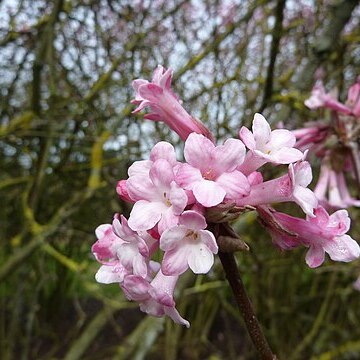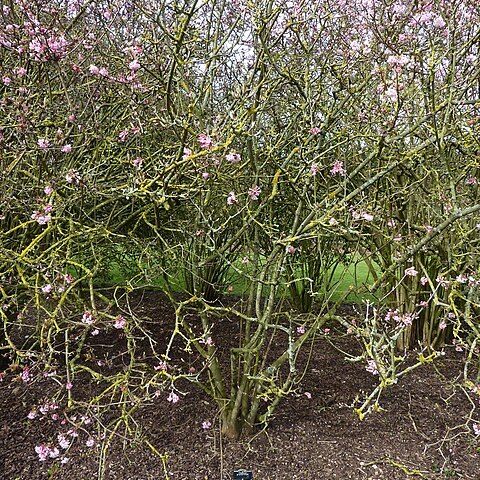Shrubs or small trees, deciduous, to 5 m tall. Bark gray-brownish. Branchlets of current year green, glabrous or sometimes pubescent; branchlets of previous year gray or brown, trabeculate, glabrous, with sparse, dispersed, small, rounded lenticels. Winter buds ellipsoid, with 2 or 3 pairs of separate scales; scales reddish brown, ciliate, apex acute. Leaves always opposite, not clustered at apices of branchlets; stipules absent; petiole purplish, robust, 1-1.5 cm, sparsely stellate-pubescent or glabrous; leaf blade purplish green when young, elliptic-oblong, rarely elliptic or obovate-elliptic, 6-10 × 2.5-4 cm, papery, abaxially densely pubescent, adaxially sparsely pubescent, later pubescent only on veins and in axils of veins abaxially, midvein raised abaxially, lateral veins 6-10-jugate, pinnate, straight or slightly arched, branched, ending in teeth, raised abaxially, impressed adaxially, veinlets transverse, inconspicuous or slightly impressed on both surfaces, not lobed, base cuneate, without glands, margin crenate-serrate except at base, apex acuminate. Flowers appearing before leaves; inflorescence paniculate, densely clustered at apices of leafless short branchlets, 2-7 × 3-4 cm; rays opposite, decussate; first node of inflorescence with 2 rays, lax, sericeous, without large sterile radiant flowers, subtended by ovate to orbicular-ovate scales; outer scales nearly leaflike, to ca. 1 cm, intense brown, pubescent or glabrous; inner scales tomentose on margins of both sides; scales deciduous when inflorescence opens; peduncles very short when flowers just open, later gradually elongated; bracts caducous, leaflike, reddish, oblong to linear, to 1 cm, silvery sericeous at first, later glabrous; bracteoles oblong to linear. Flowers on rays from 1st to 3rd orders, fragrant, sessile. Calyx reddish; tube tubular, ca. 3 mm, glabrous; lobes triangular, small, ca. 1 mm, glabrous, apex obtuse. Corolla pink outside, white inside, hypocrateriform, ca. 1 cm in diam., glabrous; tube to 1 cm; lobes spreading, broadly ovate, 4-5 mm, apex rounded, margin entire. Stamens shorter than corolla, inserted at or above middle of corolla tube, generally at different heights; filaments ca. 3 mm; anthers yellow, elliptic-oblong, ca. 2 mm. Styles exceeding calyx lobes; stigmas discoid, 2-lobed. Fruit initially turning yellow, maturing purple-reddish, ellipsoid or oblong-ellipsoid, ca. 12 × 8 mm, usually only 1 infructescence mature, base rounded, apex rounded, glabrous; pyrenes slightly compressed, oblong, 9-11 × 5-6 mm, with 1 deep ventral groove, apex rounded. Fl. May, fr. Jun-Jul. 2n = 16.
More
A shrub. It grows to about 3 m high. It spreads 2 m wide. The leaves have stalks. The leaves are 8-10 cm long. They are oval and have teeth around the edge. They are hairy on the veins underneath. The flowers are pinkish and have a scent. The fruit are red, then black. They are oval. They are 2 cm long.


